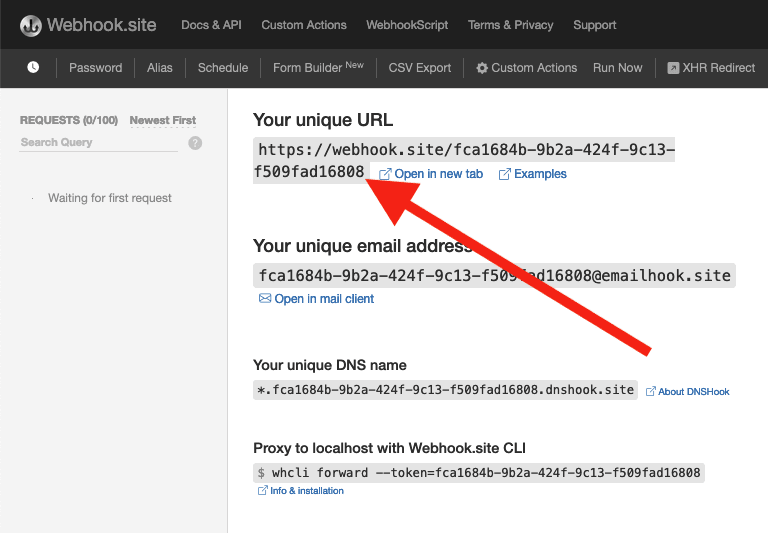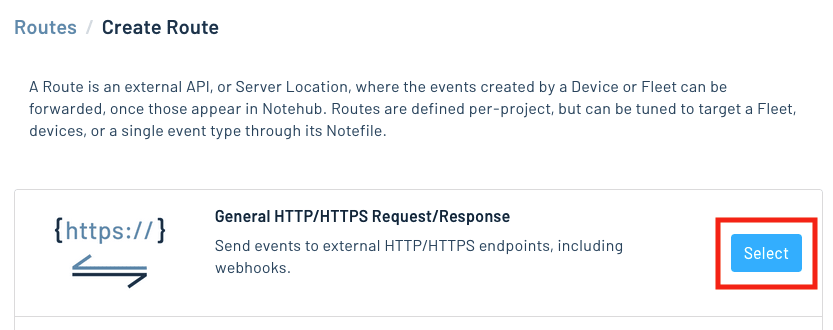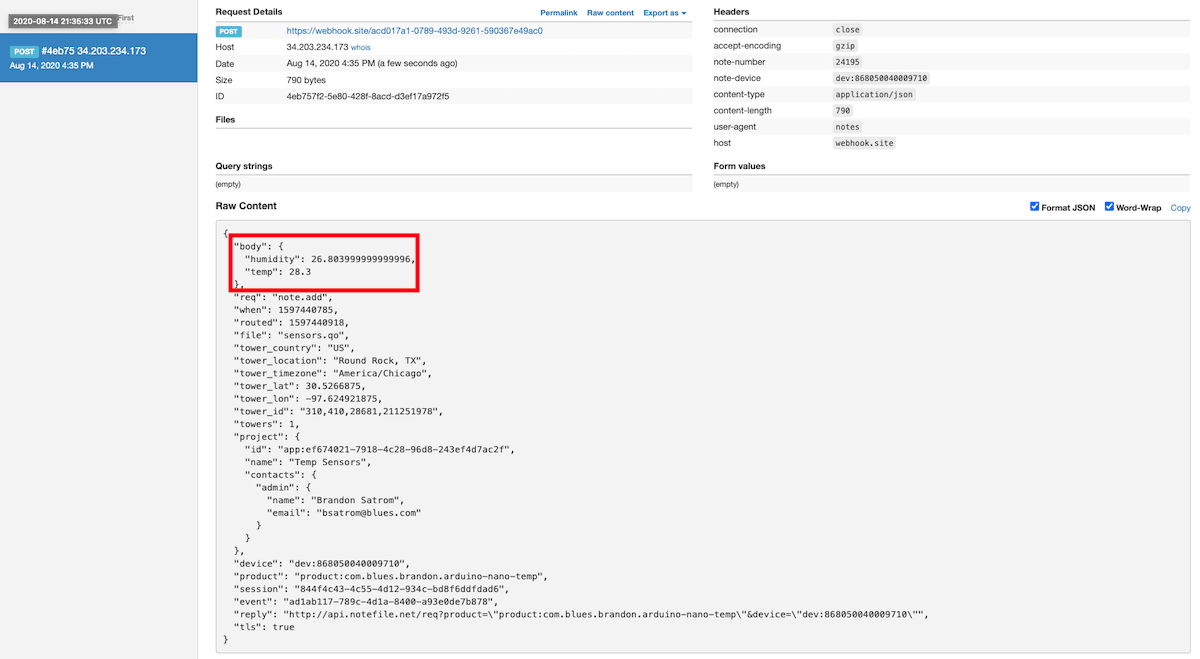Routing Data to Cloud: Snowflake
Watch a video of this tutorial
In previous tutorials you've learned about the Blues Notecard, and used it to collect data and send it to Notehub, the Blues cloud service.
One powerful feature of Notehub is routes, which allow you to forward your data from Notehub to a public cloud like AWS, Azure, or Google Cloud, to a data cloud like Snowflake, to dashboarding services like Datacake or Ubidots, or to a custom HTTP or MQTT-based endpoint. The tutorial below guides you through sending data to several popular services, and teaches you how to build visualizations using that data.
Don't see a cloud or backend that you need? Notehub is able to route data to virtually any provider. If you're having trouble setting up a route, reach out in our forum and we will help you out.
Introduction
This tutorial should take approximately 30-40 minutes to complete.
In this tutorial, you'll learn how to connect your Notecard-powered app to Snowflake, and learn how to start creating simple visualizations with sensor data.
This tutorial assumes you've already completed the initial
Sensor Tutorial to capture
sensor data, saved it in a Notefile called
sensors.qo, and sent that data through the Notecard to Notehub (or that
you've already created your own app with sensor data and are ready to connect
your app to external services).
Create a Route
A Route is an external API, or server location, where Notes can be forwarded upon receipt.
Routes are defined in Notehub for a Project and can target Notes from one or more Fleets or all Devices. A Project can have multiple routes defined and active at any one time.
Before you create a Route, ensure the data you want to route is available in Notehub by navigating to the Events view.

We'll start with a simple route that will pass Notecard events through to webhook.site, where you can view the full payload sent by Notehub. Using this service is a useful way to debug routes, add a simple health-check endpoint to your app, and familiarize yourself with Notehub's Routing capabilities.
-
Navigate to webhook.site. When the page loads, you'll be presented with a unique URL that you can use as a Route destination. Copy that URL for the next step.

-
Navigate to the Notehub.io project for which you want to create a route and click on the Routes menu item in the left nav.
-
Click Create Route.

-
Select the General HTTP/HTTPS Request/Response route type.

-
Give the route a name (for example, "Health").

-
For the Route URL, use the unique URL you obtained from webhook.site.

-
In the Notefiles dropdown, choose Select Notefiles and enter the name of the Notefile to monitor. For example, we used
sensors.qofor the sensor tutorial.
-
Make sure the Enabled switch remains selected, and click Create Route.
-
Return to webhook.site. This page will update automatically with data from your Notecard as it is received in Notehub. The data from your sensor is contained within the
bodyattribute. Notice that Notehub provides you with a lot of information, by default. In the next section, we'll look at using transformations to customize what Notehub sends in a Route.
Use JSONata to Transform JSON
Before moving on to routing data to another external service, let's briefly explore using JSONata to transform the data Notehub routes.
As mentioned above, Notehub provides a lot of information in each Route request. You may want to trim down what you send to the external service, or you might need to transform the payload to adhere to a format expected by that service. Either way, Notehub supports shaping the data sent to a Route using JSONata.
More About JSONata
To learn more about JSONata, have a look at the Blues JSONata Guide.
Transform Your Data
Let's try a simple query to the webhook.site route created in the last section.
-
Navigate to the Routes page in Notehub and click View next to the Route you wish to edit.

-
In the Transform JSON drop-down, select JSONata Expression.

-
In the JSONata expression text area, add the following query to select the temp and humidity from the body, create a location field that concatenates the
tower_locationandtower_countryfields, and create a time field.{ "temp": body.temp, "humidity": body.humidity, "location": tower_location & ', ' & tower_country, "time": when } -
Click Save Route. Then, navigate back to your webhook.site url. As requests come in, you'll see your custom, JSONata-transformed payload in the Raw Content section.

JSONata is simple, powerful, and flexible, and will come in handy as you create Routes for your external services. To explore JSONata further, visit our JSON Fundamentals guide.
Route to an External Service
Now that you've created your first Route and learned how to use JSONata to shape the data sent by a Route, you'll connect Notehub to an external service.
In this section of the Tutorial, you'll connect your app to Snowflake, a data cloud platform that is a perfect repository for your app's sensor data. You'll create a simple data warehouse for your app data, create a Route from Notehub that uses the Snowflake REST API to add that data into your warehouse, and finally, you'll build an interactive app for data visualization using the Streamlit platform.
Create a Snowflake Account
If you haven't already, create a Snowflake account. The provided 30-day trial should be plenty to get you started exploring the product.

Create a Public Private Key Pair for Authentication
-
Follow this guide from Snowflake to configure a public and private key for key pair authentication between Notehub and Snowflake.
-
Once you've created a public key, you'll need to associate it to your Snowflake user account. Open or create a new Workbook in your Snowflake portal and run the following, replacing the username and public key values:
alter user [your_user_name] set rsa_public_key='MIIBIjANBgkqh...';- Then, run
desc user [your_user_name];and verify that your key is set in theRSA_PUBLIC_KEYfield.

Notehub will ask for the Private key when you configure the Route, so be sure to save that file in a location you'll remember later.
Create a Snowflake Database and Table
Next, you'll need to create a Database and Table in your Snowflake Account.
- Open or create a new workbook and run the following to create a database and set it as active for future statements.
create or replace database bme680_data;
use database bme680_data;- Next, create a table with a single column of type
variant. The variant data type is a perfect container for the raw JSON that we'll be routing from Notehub to Snowflake. Even better, Snowflake has a mechanism for creating structured data from semi-structured sources like JSON, which you'll explore in the next part of this tutorial.
create or replace table sensor_data(payload variant);Create a Route in Notehub
- To create a Snowflake Route, you'll need to grab your organization and account name from Snowflake. You can find these in your Snowflake account dashboard at the lower left.

-
Next, Open your Notehub project, click the Routes item in the left navigation and click "Create Route" in the top right.
-
Click the "Select" button in the Snowflake row.

- Give the Route a name, and in the configuration section, enter your Snowflake organization and account names, your user name, and upload the private key you generated at the start of this tutorial.

- In the Filters section, choose "Selected Notefiles" and select your "sensors.qo" Notefile.

- In the Data section, change the JSONata expression from the default to map to the database name and table you created above.
{
"statement": "insert into SENSOR_DATA (payload) select parse_json($$" & $[0] & "$$)",
"timeout": 60,
"database": "BME680_DATA",
"schema": "PUBLIC",
"role": "ACCOUNTADMIN"
}-
Finally, click the "Create new Route" button to activate your Route.
-
To confirm that your Route is working as Notehub receives events from the Notecard, select the Events view, select any event for the
sensors.qoNotefile and click the "Route Log" tab. If you see a status of200from Snowflake, you've wired things up correctly.

- On the Snowflake side, navigate to your workbook and run the following query:
select * from sensor_data;- You should see JSON object in the payload field for each sensor reading from your Notecard.

With data flowing from the Notecard through Notehub to Snowflake, the next step is to create a UI for data visualization.
Build Data Visualizations
In this section of the tutorial, you'll learn how to shape semi-structured JSON data into views for easier querying, and then use the open source Streamlit framework to create a dashboard for your sensor data.
Create Snowflake Views from JSON Data
In the last section, you created a Route to send raw JSON from Notehub to Snowflake and store that data in a table, unmodified. One powerful feature that Snowflake provides is the ability to stream your Notehub events into a warehouse as they arrive and then process and shape that data at a later point without modifying your Notehub Routes, or shaping the payloads sent to the Notecard.
This is possible because Snowflake can recognize valid JSON in a variant
field of a table and provides a syntax for traversing a JSON object and
selecting data from it. As a result, we can create views in Snowflake that
apply structure to semi-structured JSON data sent from Notehub without
affecting the underlying data.
- In your Snowflake dashboard, create or open a workbook and run the following to switch to your sensor data database.
use database bme680_data;- Then run the following to create a view. Notice that the
payload:syntax allows you to select fields directly from the raw JSON from Notehub, and that you can even traverse objects and select properties from the event body using dot notation.
create or replace view
sensor_vw
as select
payload:event::STRING as id,
payload:device::STRING as device,
payload:when::TIMESTAMP as created,
payload:best_lat::FLOAT as lat,
payload:best_lon::FLOAT as lon,
payload:best_location::STRING as location,
payload:best_location_type::STRING as location_type,
payload:best_timezone::STRING as timezone,
payload:best_country::STRING as country,
payload:body.temp::FLOAT as temp,
payload:body.humidity::FLOAT as humidity
from sensor_data;- Next, run the following to see the results of your view: a structured table with the schema you defined above.
select * from sensor_vw;
Create a Streamlit App to Vizualize Sensor Data
Now let's create a simple Streamlit app retrieve sensor readings and visualize data. Streamlit is an open-source Python library that makes it easy build web apps using popular Python data packages like Numpy and Pandas. It also provides an integration with Snowflake, which is perfect for this guide. Streamlit also provides a hosted cloud for Streamlit apps, but for this tutorial you'll use the local version.
-
First, use this guide to install Streamlit for your environment.
-
Next, create a directory for your application, like
streamlit-sensors. -
Add a file called
requirements.txtwith the following:
altair
pandas
streamlit
snowflake-connector-python==2.7.6
matplotlib- Now set up a virtual environment for the app. Open a terminal program and run the following to create and activate a Python virtual environment:
python3 -m venv env
source env/bin/activate- Run the following to install all of the needed dependencies in your virtual environment.
pip install -r requirements.txt- Create a directory called
.streamlitand add a file inside of that directory calledsecrets.toml. Then, add the following, making sure to replace the placeholder text with your username, password, and Snowflake organization and account name.
[snowflake]
user = "[your_user_name]"
password = "[your_password]"
account = "[your_organization_name]-[your_account_name]"
warehouse = "COMPUTE_WH"
database = "BME680_DATA"
schema = "PUBLIC"-
Create a new Python file called
streamlit_app.pyand open it in your text editor of choice. -
Add the following imports to the top of the file:
import streamlit as st
import pandas as pd
import snowflake.connector- Next, add some logic to connect to your Snowflake database as well as a function to handle queries to your sensor data.
# Initialize connection.
@st.experimental_singleton
def init_connection():
return snowflake.connector.connect(**st.secrets["snowflake"])
conn = init_connection()
# Perform query.
@st.experimental_memo(ttl=600)
def run_query(query):
with conn.cursor() as cur:
cur.execute(query)
return cur.fetchall()- Streamlit has some built-in smarts that can turn multi-line comments and markdown into content on the resulting web page. Add the following, which Streamlit will process as a header element and text when the page is rendered.
"""
# BME680 Sensor Data
This page shows sensor readings and device location from a Blues
Notecard-connected BME60.
"""- Streamlit also provides a number of form elements that can be used to add easy interactivity to your app. The values of form elements are bound to variables, and as those variables change, dependent data and UI elements change as well. Add the following to your app to add a slider, select box and a few checkboxes.
"""
### Options
"""
num_rows = st.slider('Rows to fetch?', 10, 500, 100)
sort = st.selectbox('Sort?',('asc', 'desc'))
show_table_data = st.checkbox('Show table data?', True)
show_charts = st.checkbox('Show charts?', True)
show_map = st.checkbox('Show map?', False)- Now run the app. Navigate back to your terminal and run the following:
streamlit run streamlit_app.py- As the app loads, Streamlit will open a new tab in your default browser and render the page with the elements you provided above.

- Next, add the following lines to fetch data from Snowflake and place that data into a
Pandas DataFrame. Notice that we're using a Python format string and the
sortandnum_rowsvariables in the query. As mentioned above, these variables are bound to the UI elements on the page, and as they change, the query will re-run.
sensor_rows = run_query(f'SELECT * from sensor_vw ORDER BY created {sort} LIMIT {num_rows};')
sensor_data = pd.DataFrame(sensor_rows, columns=("ID", "Device", "When", "lat", "lon", "Location", "Location Type", "Timezone", "Country", "Temp", "Humidity"))- With a DataFrame in hand, we can add our first visualization, starting with a simple table view of all sensor readings.
if show_table_data:
"""
## Notecard `sensors.qo` Events
"""
# Flip the column order to show temp and humidity first. If you don't
# want to do this, change the line below to sensor_data.
sensor_data[sensor_data.columns[::-1]]- When Streamlit detects that a source file has changed, it will notify you with a message in the top-right corner. Click "Rerun"or "Always Rerun" to reload the app.
![]()
- After the page reloads, you'll see a table view of your Sensor data from Snowflake.

- Now let's add a chart of temperature and humidity data over time, using the
Streamlit
line_chartfeature.
if show_charts:
"""
### Environment Chart
"""
sensor_group = sensor_data[["Temp", "Humidity"]]
st.line_chart(sensor_group)- When the page reloads, you'll see a line chart of temperature and humidity readings.

- Finally, add a map using the Streamlit
mapAPI.
if show_map:
"""
### Tracker Map
"""
sensor_locations = sensor_data[["lat", "lon"]]
st.map(sensor_locations)- When the page reloads, you'll see a map of device locations.

Next Steps
Congratulations! You've created your first Route and connected your Notecard app to an external service.
If you're following the Blues Quickstart, you're done! But we do have some suggestions for next steps:
- Browse the Blues Accelerators to find purpose-built, free and open source IoT solutions.
- Bookmark the Notecard API for quick reference.
- Follow the Notehub Walkthrough to get more out of using Notehub.
At any time, if you find yourself stuck, please reach out on the community forum.
